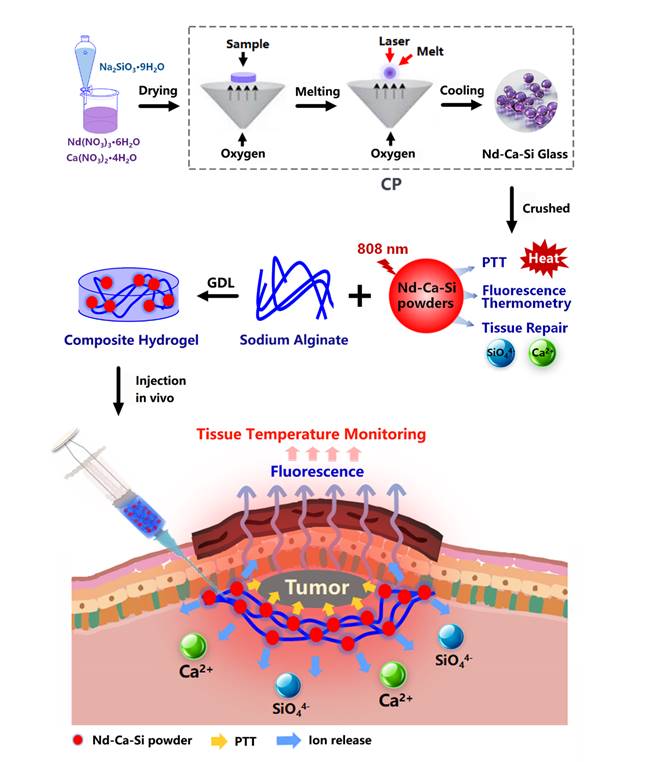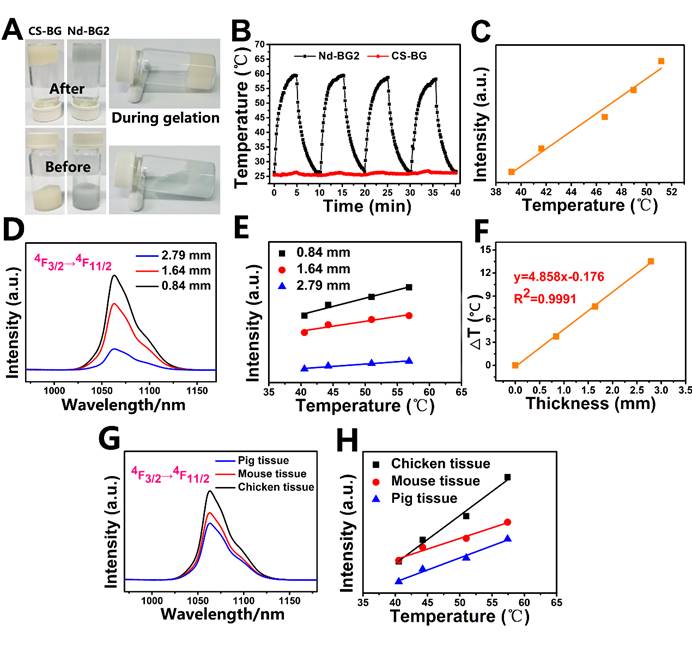A New Type of Multifunctional Bioactive Glass Material is Fabricated for Tumor Treatment and Tissue Regeneration
Photothermal therapy (PTT) shows its unique advantages as a new tumor treatment method. However, it is difficult to measure the accurate temperature of the tumor site by the traditional PTT. The excessive temperature during PTT may damage the surrounding healthy tissue, while low temperature may not be able to kill the tumor cells completely. Therefore, to determine the photothermal temperature in situ is an urgent need for discovering the optimal temperature and repairing the burn tissues during PTT treatment simultaneously. It is of great significance to develop multifunctional bioactive materials, which not only possess photothermal property for PTT, but also can accurately measure the temperature of the tumor site and repair burn damaged normal tissue.
Recently, the research group led by Profs. CHANG Jiang and WU Chengtie at Shanghai Institute of Ceramics made new progress in multifunctional bioglass for in-situ photothermal therapy, fluorescence monitoring PTT temperature and burn tissue repair. The group designed and successfully fabricated a new type of multifunctional bioactive glass material, which features photothermal property for PTT, fluorescence emitting property for monitoring tumor temperature, and bioactivity to repair burn normal tissues caused by high photothermal temperature simultaneously. The result was published in Science Advances (Sci. Adv. 2020; 6:eabb1311,DOI:https://doi.org/10.1126/sciadv.abb1311) and applied for an invention patent. The first author is MA Lingling, a PhD student, and the supervisor and corresponding author is Prof. CHANG Jiang.
The new type of multifunctional Nd-Ca-Si-based bioglass was fabricated by doping the rare earth element Nd into the bioactive calcium silicate based material using the containerless processing technique. Moreover, the multifunctional Nd-Ca-Si bioglass/alginic injectable hydrogel was prepared, which could be easily injected into the tumor site in situ. Meanwhile, the effect of the composite hydrogel in tumors treatment under different temperatures as well as the burn degree of normal tissues at different temperatures were studied systematically. Thus the optimal PTT temperature was determined, which could effectively eliminate tumors and avoid/reduce the burn damage of surrounding normal tissues. It is found that the bioactive components released by the composite hydrogel could significantly promote cell proliferation, migration and angiogenesis. Animal experiments showed that the composite hydrogel could effectively repair the burn tissues induced by the PTT. The biocompatibility study revealed that the implanted hydrogel did not have any toxic effect on tissues and important organs. The multifunctional biomaterials will not only have potential application for PTT tumor therapy, but also be used as a temperature monitoring material for measuring in situ temperature in other types of thermal therapies.
This work was supported by the National Key Research and Development Program of China, the National Natural Science Foundation of China, and the Science and Technology Commission of Shanghai Municipality.
Reference:
https://doi.org/10.1126/sciadv.abb1311


Photothermal/fluorescence properties of the Nd-BG2 composite hydrogel in vitro. (A) Images of the formation of Nd-BG2 composite hydrogels. (B) Heating curves of the Nd-BG2 and CS-BG composite hydrogels (under 808-nm laser irradiation at the power density of 1.5 W cm-2). (C) Linear fitting relationship between 1062-nm fluorescence intensity and temperature for Nd-BG2 composite hydrogels. (D) Room temperature emission spectra of the hydrogel through the mouse tissues with different thickness (1.12 W cm-2). (E) Linear relationship between fluorescence intensity through mouse tissues with different thicknesses and the temperature. (F) Relationship between temperature difference (DT) and thickness of mouse skin tissue. (G) Room temperature emission spectra of the hydrogel through different animal tissues with same thickness (1.64 mm; under 808-nm laser irradiation at the power density of 1.12 W cm-2). (H) Linear relationship between fluorescence intensity through different animal tissues with same thickness and temperature.
Contact:
CHANG Jiang
Shanghai Institute of Ceramics
Email: jchang@mail.sic.ac.cn



